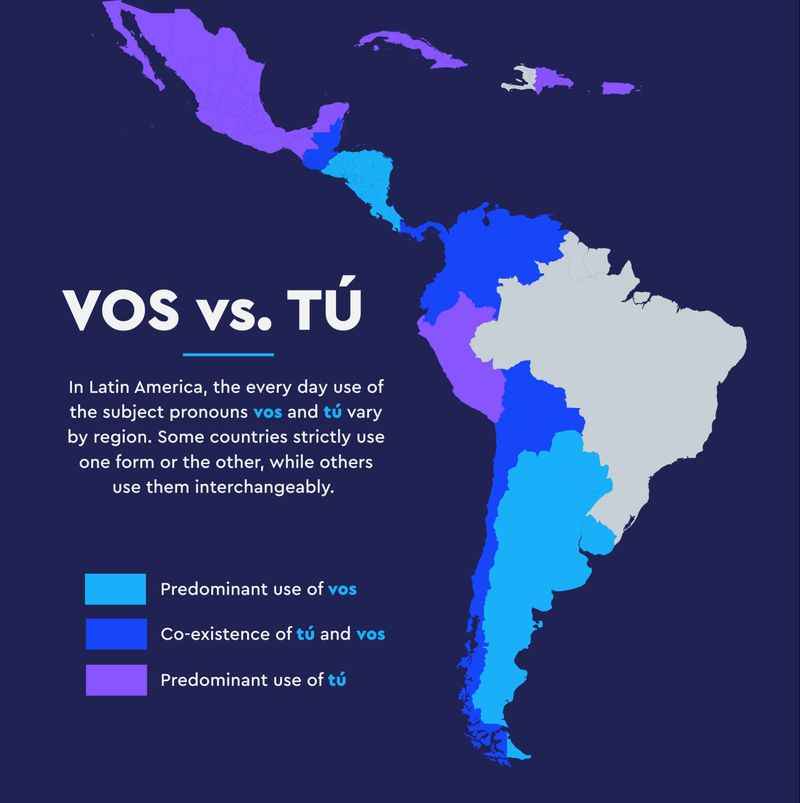Argentine Spanish - How Different is it Really?
The vast majority of languages have evolved to comprise numerous accents and dialects. Given its sheer volume of speakers around the world, (some 580 million people), there are few languages in which this is more evident than Spanish.
Spanish is the official language of more than twenty countries, the vast majority of which are in South and Central America, more than 5,000 miles away from the language’s native Spain. Each of these countries is home to numerous regional and local accents, as well as national and regional vocabulary.
The variation between the Spanish of Latin American countries and Castilian Spanish - that is, the Spanish most commonly spoken in central and northern Spain, varies greatly.
Today, we focus on one country in particular - Argentina. The southernmost South American country has a fascinatingly unique type of Spanish, which differs tremendously from the Castilian Spanish from which it originates.
Today, we will answer the following questions:
- How does Argentine Spanish differ to Castilian Spanish?
- Why does Argentine Spanish sometimes sound Italian?
- How different is Spanish grammar in Argentina?

Argentine Spanish - Why do Argentinians sound different?
Argentinian Spanish is often referred to as Rioplantense Spanish, which is a dialect of Spanish originally from the Rio de la Plata region, between Argentina and neighboring Uruguay.
Initially, this region was conquered by Spain, later receiving an influx of migration from Italy. In the latter half of the 19th century and the early half of the 20th century, Italian immigrants arrived in Argentina to take advantage of the country’s economic growth.
In fact, more than 70% of the Argentine population possess some degree of Italian descent.
As a result of the country’s immigration history, Argentine Spanish is often described as a combination of Spanish and Italian.
In fact, whilst Spanish is the official language, the intonation of Argentine Spanish is much more similar to Italian; for a non-Spanish speaker, it would be very easy to confuse the two languages.
Main differences between Castilian Spanish and Argentine Spanish

Although the term ‘Castellano’ in Spain refers to the Spanish language as a whole, Castilian Spanish is actually the variety of Peninsular Spanish spoken in northern and central Spain.
Other dialects in Spain include Andalusian Spanish (in the south of the country) and Canarian Spanish (in the Canary Islands). Castilian Spanish is frequent on Spanish radio and television, and generally, the Spanish is taught in schools across Europe.
There are a number of factors that make Argentine Spanish fascinatingly unique, different not only from the countries above it but also its original Castilian Spanish.
1. Grammar
One of the fundamental differences between many other types of Spanish and Argentine Spanish is the use of grammar and verb conjugation. In fact, this is one of the many aspects which make the Argentine accent unique, due primarily to the placement of the accent, thus the stress on the word.
If you have already learned how to conjugate Spanish verbs, then learning the Argentine Spanish conjugation rules will not be difficult. Let’s go through them now:
❇️ AR verb conjugations ending in ‘as’ | Replaced with ‘ás’ - (Check out our AR verb guide). ❇️ ER verb conjugations ending in ‘es’ | Replaced with ‘és’. ❇️ IR verb conjugations ending in ‘es’ | Replaced with ‘ís’.
The question ‘where do you live?’ in Spanish - ‘Dónde vives?’ becomes ‘Dónde vivís?’ in Argentine Spanish.
2. Vos - How to Conjugate the 'voseo' form
**
Argentine Spanish uses a different pronoun in the second person singular (you). In Argentine Spanish, ‘vos’ is an informal way of saying ‘you’.
In Castilian Spanish, speakers use the word ‘tú’ instead of ‘vos’. Whilst Argentines understand the Castilian Spanish form, which is also used throughout Latin America, they do not use it.
Interestingly, and often confusing for learners of Spanish, the Argentine ‘vos’ form also has its own set of conjugations, depending upon the verb.
🌎 Verbs ending in -AR | hablar: Vos hablás (you speak)
🌎 Verbs ending in -ER | hacer: Vos hacés (you do/make)
🌎 Verbs ending in -IR | escribir: Vos escribís (you write)

Examples of the 'voseo' form
Fortunately, there are no stem changers in the vos form. Below are some examples of stem changing verbs in second person singular 'voseo' form.
🌎querer (to want) Vos querés | tú form: quieres
🌎tener (to have) Vos tenés | tú form: tienes
🌎entender (to understand) Vos entendés | tú form: entiendes
Both Castilian and Argentine Spanish use the same formal you form, which is ‘usted’ in the singular and ‘ustedes’ in the plural.

3. Lunfardo - Confusing even to Argentines!**
As is the case in any other Spanish-speaking country, Argentine Spanish contains its own set of national and regional vocabulary and slang. We’ll focus on one particular aspect of this, something which is completely unique to Argentina.
Buenos Aires, the country’s capital, is the birthplace and home of ‘Lunfardo.’ Lunfardo is popular slang that originated and developed in the late 19th and early 20th centuries.
From Buenos Aires, it spread to other cities nearby, such as the surrounding area of Greater Buenos Aires, Rosario, and Uruguay’s capital city, Montevideo. Interestingly, it did not spread as far as Portuguese-speaking Brazil.
One of the ways in which these slang words came to existence was through reversing letter orders in the word. For this reason, it is often incomprehensible to many Spanish speakers outside of Argentina, and indeed to many Argentinians.
You’ll notice from the examples below that the letters of these words are rearranged from their originals.
Examples of lunfardo:

❇️ Garpar: to pay, the inverse of pagar
❇️ Jermu: a man’s wife, the inverse of mujer
❇️ Dorima: a woman’s husband, the inverse of marido❇️ Jonca: a casket or coffin, the inverse cajón❇️ Joraca: inversion of carajo❇️ Langa: an attractive but self-centered man, the inverse of galán❇️ Los lompa: pants, inverse of pantalón
4. Hand Gestures

In general, Argentines like to hablar con las manos (“talk with their hands”). In other words, they are very expressive with their body language. Interestingly, Argentines have their own, unique set of gestures which would certainly cause confusion in any other country.
In fact, it is not uncommon for Argentines to use a gesture instead of speaking in some social situations. One of the most common of these is to brush one's fingertips along the underside of one's neck. This simply means - “I don’t know”.
Another is to pull the skin below one's eyes with the index finger. This is a way to tell somebody to watch out or to be careful.
You may recall that previously in this post we touched on Argentina's rich history of immigration, particularly from Italy. Perhaps this is more apparent than ever when Argentines are placed into situations that leave them in disbelief.
In Argentina, the sentiment behind “Are you kidding me?” is expressed by extending your arm, touching your fingers with your thumb with your wrist facing downwards, and shaking your hand back and forth.
Any football fans will see Argentine players do this frequently to express disagreement with a referee. This is often accompanied by the phrase ¿Me estás cargando? (“Are you kidding me?”), another expression unique to Argentine Spanish.
[embed]https://www.youtube.com/watch?v=1M2m8U4LvB4
5. Unique Vocabulary and Phrases
We've established by now that Argentine Spanish is rich in many ways. Nowhere is this more apparent than in its unique set of vocabulary and phrases. Argentine Spanish is drastically different from Cuban slang words, for example.
Understanding local colloquialisms will help you to connect with Argentines and understand the local culture. Here are our top 3 Argentine phrases:
❇️ Estar al horno (con papas) ❇️ Literal translation: to be in the oven (with chips).
This means that somebody is in serious trouble. An example may be the inability to pay a large debt, having to sit an exam you have not studied for or realizing you've forgotten to do something important. In this case, you would say “.Estoy al horno!”
❇️ Ponerse las pilas ❇️ Literal translation: to put your batteries in.
By telling somebody to**'ponerse las pilas'** you are implying that they need to wake up. This could mean they need some energy, or simply that they are not concentrating when they should be. An example might be prior to heading to a party - “.Ponete las pilas y vamos!” (Put your batteries in and let’s go!).
❇️ Estar al pedo/estar en pedo ❇️ Literal translation: to be in a fart.
Yes, that's correct. In fact, there are dozens of phrases related to farting in__ Argentine slang_. Estar al pedo_ means that you’re lazy or idle. To say “**_Estoy al pedo_**” to somebody is to let them know that you're not doing anything.
Summing up Argentine Spanish
Argentine Spanish differs from all other varieties of Spanish in numerous ways. This is due to its unique and extensive range of dialects, vocabulary, grammar, slang, and intonation.
Furthermore, the country’s fascinating history and the influx of predominantly Italian migration in the early twentieth century is one of the key reasons that Argentine Spanish is so unique.
We hope Argentine Spanish is now clearer for you and that this post has brought some needed clarity on the matter. Buena suerte on your Spanish journey!







